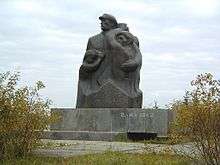Audriņi
Audriņi is a village in Audriņi Parish, Rēzekne Municipality of the Latgale area of eastern Latvia, 245 km east of Riga.

History
The tragedy during World War II
The village of Audrini was completely eradicated and its entire population was liquidated on 3 January 1942.[1] In total 215 inhabitants were killed, including 51 children; later, on 4 January 1942, 30 of them were shot on the market square in Rēzekne; the others in the Ančupāni hills.
The Latvian police commander who organized and carried out the massacre, one Boleslavs Maikovskis, was recruited by the US Central Intelligence Agency at the end of World War II to work for the US Government's operations against the Soviet Union. He was later allowed to emigrate to the United States via the CIA's "rat line", which assisted hundreds of wanted World War II war criminals in escaping justice at the hands of a war crimes tribunal. In 1966, the US Department of Justice and FBI produced a document as part of their proceedings to revoke the citizenship of Maikovskis. The document relates the story of the Audrini massacre: "Boleslavs Maikovskis, the former Chief of the II Section of the Rezekne District police [...] and Eihelis were the ones who energetically responded to the order that the village of Audrini be wiped off the face of the earth. On a cold winter night, in December, 1941, Eihelis' and Maikovskis' policemen burst into Audrini, drove the occupants from their houses, arrested them, and took them to the Rezekne jail. After the looting of the village, he gave the signal to put fire to the buildings. In this way, under the supervision of the police, all 42 farmers' houses burned to the ground. as a result of the 'successful' operation, a feast took place in the Rezekne District Police Headquarters, with foodstuffs looted in Audrini.
"Soon after that, on the evening of January 3, a ghastly column of trucks left the Rezekne jail. The murderers were taking 170 inhabitants of Audrini, including 51 children, to be killed in the Ancupani hills. After rifle salvos had done their work, Eihhelis still walked around the piles of victims and shot his pistol in order to finish off those people who still showed signs of life. On January 4, 1942, on the Rezekne city-market place, Eihelis directed the public shooting of 30 men and adolescents from Audrini village." [2]
The U.S. Central Intelligence Agency's Freedom of Information Act Electronic Reading Room has an entire set of documents pertaining to the case of Boleslavs Maikovskis.[3]
External links
References
- Valdis O. Lumans (1996). Latvia in World War II. Fordham University Press.
- U.S. Department of Justice, Federal Bureau of Investigation, N.Y., N.Y. (1966), Boleslavs Maikovskis (PDF), New York, N.Y.: Central Intelligence Agency, p. 12, retrieved 12 March 2014CS1 maint: multiple names: authors list (link)
- Central Intelligence Agency. "Maikovskis". Central Intelligence Agency. Archived from the original on 12 March 2014. Retrieved 12 March 2014. Cite journal requires
|journal=(help)